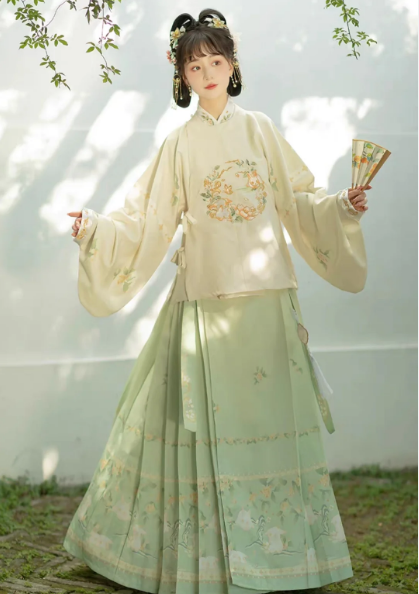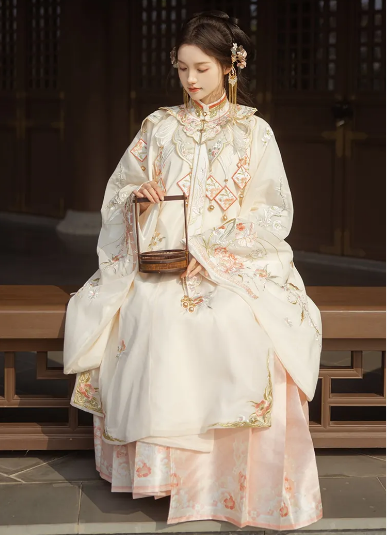To wear Ming Dynasty hanfu, follow traditional dressing steps, including layering robes, adjusting for fit, and styling with cultural significance.
Overview of Ming Dynasty Hanfu
The Ming Dynasty, spanning from 1368 to 1644, witnessed a resurgence in traditional Han culture, significantly influencing the hanfu, China’s traditional dress. This period’s hanfu is distinguished by its vibrant colors, intricate patterns, and symbolic designs, echoing the era’s artistic and cultural prosperity.
Historical Significance
Hanfu during the Ming Dynasty was more than just clothing; it embodied the philosophical and cultural ideals of the time. Confucianism, with its emphasis on ritual and propriety, played a pivotal role in shaping the hanfu’s styles and etiquette. The garments not only reflected one’s social status but also demonstrated adherence to cultural norms and values. For instance, the use of dragon motifs was typically reserved for the emperor, symbolizing imperial power and authority.

Key Features and Styles
Ming Dynasty hanfu is characterized by its layered complexity and attention to detail. One typical style was the cross-collared robe, often complemented by a long, flowing skirt or trousers. Fabrics ranged from silk to linen, featuring intricate embroideries of nature-inspired motifs like flowers, birds, and dragons. The colors were not arbitrary; they followed a strict code, with certain hues designated for specific ranks and occasions. For example, bright yellow was exclusively worn by the emperor, while commoners often wore more subdued colors.
The hanfu’s evolution during the Ming Dynasty reflects a period marked by both adherence to tradition and innovative craftsmanship. These garments, beyond their aesthetic appeal, served as a canvas to express the rich tapestry of Ming cultural and social life. Today, they continue to fascinate and inspire, both in China and globally, as a symbol of a deeply revered cultural heritage.
Components of Ming Dynasty Hanfu
The Ming Dynasty Hanfu is a testament to the rich cultural tapestry of ancient China, distinguished by its intricate components. Each piece of the attire, from robes to accessories, carried its own significance and style, mirroring the era’s aesthetics and social customs.
Robes and Jackets
Robes and jackets formed the core of Ming Dynasty attire. The pao, a type of robe, was a common garment for both men and women. These robes, often made of silk, displayed elegance through their flowing lines and long sleeves. Men’s pao typically featured round collars and side fastenings, while women’s versions were more elaborate with broad sleeves and vibrant patterns. Jackets, worn over these robes, added layers of warmth and style. They ranged from short waist-length designs to longer, knee-grazing varieties, often embellished with detailed embroidery depicting traditional Chinese motifs.
Skirts and Pants
Skirts and pants underpinned the practical aspects of Ming attire. While men predominantly wore pants, women’s clothing prominently featured skirts. These skirts, known as qun, varied in length and were often pleated or paneled for added fullness and movement. The materials used were as diverse as the designs, ranging from fine silks for the affluent to more modest cottons for the common folk. The colors and patterns of these skirts often denoted the wearer’s social status or occasion, with brighter and more intricate designs reserved for those of higher status or special events.
Accessories
Accessories played a pivotal role in completing the Ming Dynasty ensemble. Belts, often made of silk or leather, were not only functional but also a fashion statement, often adorned with jade or silver buckles. Hats were another key accessory, varying in shape and size according to one’s social rank and gender. Official headwear, for instance, was quite distinct, featuring specific designs according to the wearer’s official rank. Jewelry, including hairpins, necklaces, and bracelets, usually made of jade, gold, or pearls, added a final touch of elegance, symbolizing wealth and social status.
Each component of the Ming Dynasty hanfu was a work of art in itself, reflecting the wearer’s identity and the era’s aesthetic preferences. These garments and accessories were not just clothing but a rich visual narrative of the Ming Dynasty’s culture and societal norms.
Step-by-Step Guide to Wearing Ming Dynasty Hanfu
Wearing Ming Dynasty hanfu is an art that combines tradition with meticulous attention to detail. This guide provides a step-by-step approach to don the hanfu, ensuring both historical accuracy and elegance.
Preparing the Hanfu
Proper preparation is key to the perfect hanfu appearance. Start by carefully ironing each piece to remove wrinkles, ensuring a smooth and refined look. Silk, a common fabric for hanfu, requires a gentle touch and a low-temperature setting to avoid damage.
Once ironed, begin with the innermost layers. These typically consist of a light undergarment or shirt, which serves as the base. Next, add the zhongdan, a slightly heavier layer, often in a complementary color or design to the outer robe.
Dressing Sequence
Following the preparation, the dressing sequence is crucial for achieving the authentic Ming Dynasty look:
- Start with the Base Layer: Put on the inner shirt or undergarment, ensuring it sits comfortably against your skin.
- Add the Middle Layer: Wear the zhongdan, adjusting it to sit neatly over the base layer.
- Outer Robe: Gently put on the outer robe, the pao. This is often the most ornate piece, showcasing exquisite designs and vibrant colors.
- Skirt or Pants: Depending on gender and specific style, add either a skirt (qun) or pants under the robe.
Adjusting for Fit and Comfort
Once fully dressed, adjustments are essential for both aesthetics and comfort:
- Belt: Secure the garments with a belt, typically tied around the waist. This not only adds to the outfit’s elegance but also ensures a snug fit.
- Sleeves: Adjust the sleeves, especially if they are long and broad, to allow free movement without compromising the outfit’s integrity.
- Collar and Overlaps: Make sure the collar sits neatly, and the robe’s overlaps are aligned correctly.
Finally, add accessories like hats or jewelry to complete the look. Each element of the hanfu should harmonize with the others, creating a cohesive and graceful ensemble that reflects the rich heritage of the Ming Dynasty.

Styling and Cultural Etiquette
Ming Dynasty hanfu styling goes beyond mere clothing; it embodies a rich cultural heritage and etiquette deeply rooted in the era’s traditions. The meticulous attention to detail in the dressing process, choice of colors, and fabric types all hold significant cultural meanings, making the act of wearing hanfu a respectful nod to Chinese history.
Traditional Hairstyles and Makeup
In Ming Dynasty fashion, hairstyles and makeup played a crucial role in conveying social status and adherence to cultural norms. Women often styled their hair in elaborate updos, securing them with ornate hairpins, a practice that signified their marital status and social standing. Men’s hairstyles were simpler, usually a neat bun, reflecting the Confucian value of modesty. Makeup was subtle yet elegant, focusing on enhancing natural features. Women applied white powder to brighten their complexion and used rouge to add a gentle flush to their cheeks, aligning with the era’s beauty standards that favored a natural, understated look.
Cultural Significance of Different Styles
Each style of hanfu carried a deep cultural significance, often acting as a visual indicator of the wearer’s social position. For instance, the dragon robe, exclusively worn by the emperor, was adorned with nine dragons, symbolizing supreme power and authority. Officials’ robes were distinguished by their rank badges, which depicted birds or mythical animals corresponding to their rank. The common people wore simpler hanfu, with less elaborate designs and more practical fabrics, reflecting their place in society. The color of the hanfu also held meaning; imperial yellow was reserved for the emperor, while other colors were selected based on their symbolism in Chinese culture.
Modern Adaptations and Considerations
Modern interpretations of Ming Dynasty hanfu blend historical accuracy with contemporary fashion sensibilities. Designers often experiment with different fabrics and cuts while retaining traditional patterns and colors, making hanfu more accessible and comfortable for everyday wear. This fusion not only celebrates the rich heritage of the Ming Dynasty but also ensures its relevance and appeal in the modern world. Today, wearing hanfu is not just about fashion; it’s a way to connect with and honor Chinese cultural history, allowing people to explore and express their identity through a blend of past and present.